Topic Modeling Analysis of Social Enterprises: Twitter Evidence
Abstract
1. Introduction
2. Literature Review
2.1. Social Enterprise
2.2. Topic Modeling
3. Materials and Methods
3.1. Data Collection and Preprocessing
3.2. Topic Modeling Using LDA
4. Results
4.1. Per-Topic Word Distribution
4.2. Topic Modeling and LDA Visualization
4.3. Topic Analysis
5. Discussion
- (1)
- Strategy formation and business models: Strategic thinking for SEs must take into consideration the opportunities in the external environment for decisions over business models. Only with good commercial opportunities and corporate operations can a social enterprise achieve sustainable development (index: opportunity, enterprise).
- (2)
- Business models and social impacts: The purpose of SEs is to create social impacts and social changes. This makes the core value and philosophy of the entrepreneurs and teams critical to the operational process, as it is necessary to change and adjust business models according to the status of the society (index: team, change).
- (3)
- Social impacts and strategy formation: To create social influence, SEs must have a good social network to expand social benefits. The improvement in social problems and the change in values are often the basis for determining whether a social enterprise is successful or not (index: social, network).
6. Conclusions
Author Contributions
Funding
Acknowledgments
Conflicts of Interest
References
- Battilana, J.; Lee, M. Advancing research on hybrid organizing-insights from the study of social enterprises. Acad. Manag. Ann. 2014, 8, 397–441. [Google Scholar] [CrossRef]
- Mair, J.; Marti, I. Social entrepreneurship research: A source of explanation, prediction, and delight. J. World. Bus. 2006, 41, 36–44. [Google Scholar] [CrossRef]
- Tung, W.F.; Chiu, Y.F. Transnational sentiment analysis of social media for CSA social enterprise innovation—From the perspective of sharing economy and collaborative consumption. Inform. Manag. 2019, 26, 71–98. [Google Scholar]
- Gallouj, F.; Savon, M. Innovation in services: A review of the debate and a re-search agenda. J. Evol. Econ. 2009, 19, 149–172. [Google Scholar] [CrossRef]
- Steinskog, A.; Therkelsen, J.; Gambäck, B. Twitter Topic Modeling by Tweet Aggregation. In Proceedings of the 21st Nordic Conference on Computational Linguistics, Gothenburg, Sweden, 23–24 May 2017; pp. 77–86. [Google Scholar]
- Defourny, J.; Nyssens, M. Conceptions of social enterprise and social entrepreneurship in Europe and the United States: Convergences and divergences. J. Soc. Entrep. 2010, 1, 32–53. [Google Scholar] [CrossRef]
- Defourny, J.; Nyssens, M. Social enterprise in Europe: Recent trends and developments. Soc. Enterp. J. 2008, 4, 202–228. [Google Scholar] [CrossRef]
- Borzaga, C.; Defourny, J. The Emergence of Social Enterprise, 1st ed.; Routledge: London, UK, 2001. [Google Scholar]
- Dees, J.G.; Anderson, B.B. Framing a Theory of Social Entrepreneurship: Building on Two Schools of Practice and Thought. Res. Soc. Enterp. 2006, 1, 39–66. [Google Scholar]
- Galera, G.; Borzaga, C. Social enterprise. An international overview of its conceptual evolution and legal implementation. Soc. Enterp. J. 2009, 5, 210–228. [Google Scholar] [CrossRef]
- Poledrini, S. Unconditional Reciprocity and the Case of Italian Social Cooperatives. Nonprof. Volunt. Sec. Q. 2015, 44, 457–473. [Google Scholar] [CrossRef]
- Young, D.R. Organizational identity in nonprofit organization: Strategic and structural implications. Nonprofit. Manag. Leadersh. 2001, 12, 139–157. [Google Scholar] [CrossRef]
- Kerlin, J.A. Defining social enterprise across different contexts: A conceptual framework based on institutional factors. Nonprof. Volunt. Sec. Q. 2013, 42, 84–108. [Google Scholar] [CrossRef]
- Dacin, M.T.; Dacin, P.A.; Tracey, P. Social entrepreneurship: A critique and future directions. Organ. Sci. 2011, 22, 1203–1213. [Google Scholar]
- Folmer, E.; Nederveen, C.; Schutjens, V. Network importance and use: Commercial versus social enterprises. Soc. Enterp. J. 2018, 14, 470–490. [Google Scholar] [CrossRef]
- Perrini, F.; Vurro, C.; Costanzo, L.A. A process-based view of social entrepreneurship: From opportunity identification to scaling-up social change in the case of San Patrignano. Entrep. Region. Dev. 2010, 22, 515–534. [Google Scholar] [CrossRef]
- Bornstein, D. How to Change the World: Social Entrepreneurs and the Power of New Ideas; Oxford University Press: New York, NY, USA, 2007. [Google Scholar]
- Barton, M.; Schaefer, R.; Canavati, S. To be or not to be a social entrepreneur: Motivational drivers amongst American business students. Entrep. Bus. Econ. Rev. 2018, 6, 9–35. [Google Scholar] [CrossRef]
- Huybrechts, B.; Defourny, J. Are fair trade organizations necessarily social enterprises? Soc. Enterp. J. 2008, 4, 186–201. [Google Scholar] [CrossRef]
- Monroe-White, T.; Zook, S. Social enterprise innovation: A quantitative analysis of global patterns. Volunt. Int. J. Volunt. 2018, 29, 496–510. [Google Scholar] [CrossRef]
- Ghods, M.A. Entrepreneurial marketing: The missing link in social enterprise studies. J. Global. Entrep. 2019, 9, 1–12. [Google Scholar]
- Hazel, K.L.; Onaga, E. Experimental social innovation and dissemination: The promise and its delivery. Am. J. Community Psychol. 2003, 32, 285–294. [Google Scholar]
- Mulgan, G. The process of social innovation. Innov. Technol. Gov. Glob. 2006, 1, 145–162. [Google Scholar]
- Djellal, F.; Gallouj, F. Innovation in services and entrepreneurship: Beyond industrialist and technologist concepts of sustainable development. Innovations 2009, 29, 59–86. [Google Scholar] [CrossRef]
- Nicholls, A.; Murdock, A. Social Innovation: Blurring Boundaries to Reconfigure Markets; Palgrave Macmillan: London, UK, 2012. [Google Scholar]
- Lyon, F. Social innovation, co-operation, and competition: Inter-organizational relations for social enterprises in the delivery of public services. In Social Innovation: Blurring Boundaries to Reconfigure Markets; Nicholls, A., Murdock, A., Eds.; Palgrave Macmillan: London, UK, 2012; pp. 139–161. [Google Scholar]
- Tortia, E.; Degavre, F.; Poledrini, S. Why are social enterprises good candidates for social innovation? Looking for personal and institutional drivers of innovation. Ann. Public. Coop. Econ. 2020, 91. [Google Scholar] [CrossRef]
- Nigam, K.; McCallum, A.K.; Thrun, S.; Mitchell, T. Text classification from labeled and unlabeled documents using EM. Mach. Learn. 2000, 39, 103–134. [Google Scholar] [CrossRef]
- Deerwester, S.; Dumais, S.T.; Furnas, G.W.; Landauer, T.K.; Harshman, R. Indexing by latent semantic analysis. J. Am. Soc. Inf. Sci. 1990, 41, 391–407. [Google Scholar] [CrossRef]
- Blei, D.M.; Ng, A.Y.; Jordan, M.I. Latent dirichlet allocation. J. Mach. Learn. Res. 2003, 3, 993–1022. [Google Scholar]
- Hong, L.; Davison, B.D. Empirical study of topic modeling in Twitter. In Proceedings of the First Workshop on Social Media Analytics, Washington, DC, USA, 25 July 2010; pp. 80–88. [Google Scholar]
- Weng, J.; Lim, E.P.; Jiang, J.; He, Q. Twitterrank: Finding topic-sensitive influential Twitterers. In Proceedings of the Third ACM International Conference on Web Search and Data Mining, New York, NY, USA, 3–6 February 2010; pp. 261–270. [Google Scholar]
- Sun, L.; Yin, Y. Discovering themes and trends in transportation research using topic modeling. Transp. Res. Part C-Emerg. 2017, 77, 49–66. [Google Scholar] [CrossRef]
- Yoon, H.G.; Kim, H.; Kim, C.O.; Song, M. Opinion polarity detection in Twitter data combining shrinkage regression and topic modeling. J. Informetr. 2016, 10, 634–644. [Google Scholar] [CrossRef]
- Wang, S.; Paul, M.J.; Dredze, M. Exploring health topics in Chinese social media: An analysis of Sina Weibo. In Proceedings of the Workshops at the Twenty-Eighth AAAI Conference on Artificial Intelligence, Québec, QC, Canada, 27–31 July 2014; pp. 20–23. [Google Scholar]
- Grün, B.; Hornik, K. Topicmodels: An R package for fitting topic models. J. Stat. Softw. 2011, 40, 1–30. [Google Scholar] [CrossRef]
- Deveaud, R.; SanJuan, E.; Bellot, P. Accurate and effective latent concept modeling for ad hoc information retrieval. Doc. Numérique 2014, 17, 61–84. [Google Scholar] [CrossRef]
- Peredo, A.M.; McLean, M. Social entrepreneurship: A critical review of the concept. J. World Bus. 2006, 41, 56–65. [Google Scholar] [CrossRef]
- Amit, R.; Zott, C. Creating value through business model innovation. Sloan Manag. Rev. 2012, 53, 41–49. [Google Scholar]
- Chesbrough, H. Business model innovation: Opportunities and barriers. Long Range Plan. 2010, 43, 354–363. [Google Scholar] [CrossRef]
- Teece, D.J. Business model, Business Strategy and Innovation. Long Range Plan. 2010, 43, 172–194. [Google Scholar] [CrossRef]
- Gambardella, A.; McGahan, A.M. Business model innovation: General purpose technologies and their implications for industry structure. Long Range Plan. 2010, 43, 262–271. [Google Scholar] [CrossRef]
- Frow, P.; Payne, A. A stakeholder perspective of the value proposition concept. Eur. J. Mark. 2011, 45, 223–240. [Google Scholar] [CrossRef]
- Allee, V. Reconfiguring the value network. J. Bus. Strat. 2000, 21, 36–39. [Google Scholar] [CrossRef]
- Mair, J.; Schoen, O. Social entrepreneurial business model: An exploratory study. SSRN Electron. J. 2005, 610, 1–20. [Google Scholar] [CrossRef]
- DaSilva, C.M.; Trkman, P. Business model: What it is and what it is not. Long Range Plan. 2014, 47, 379–389. [Google Scholar] [CrossRef]
- Kokko, S. Social entrepreneurship: Creating social value when bridging holes. Soc. Enterp. J. 2018, 14, 410–428. [Google Scholar] [CrossRef]
- Schwartz, B. Transferring commercial perspectives on consumer focus to social marketing. Soc. Mark. Q. 2007, 13, 17–21. [Google Scholar] [CrossRef]
- Lawrence, A. Is SCRM really a good social media strategy. J. Database Mark. 2011, 18, 149–153. [Google Scholar]
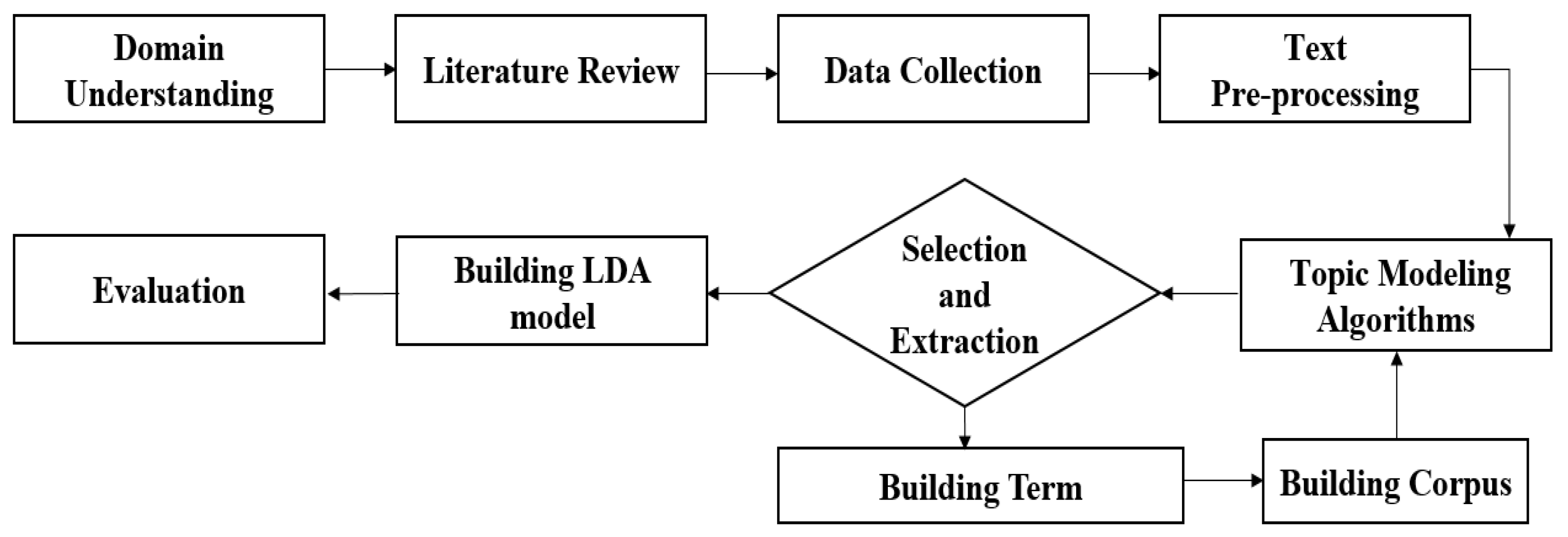
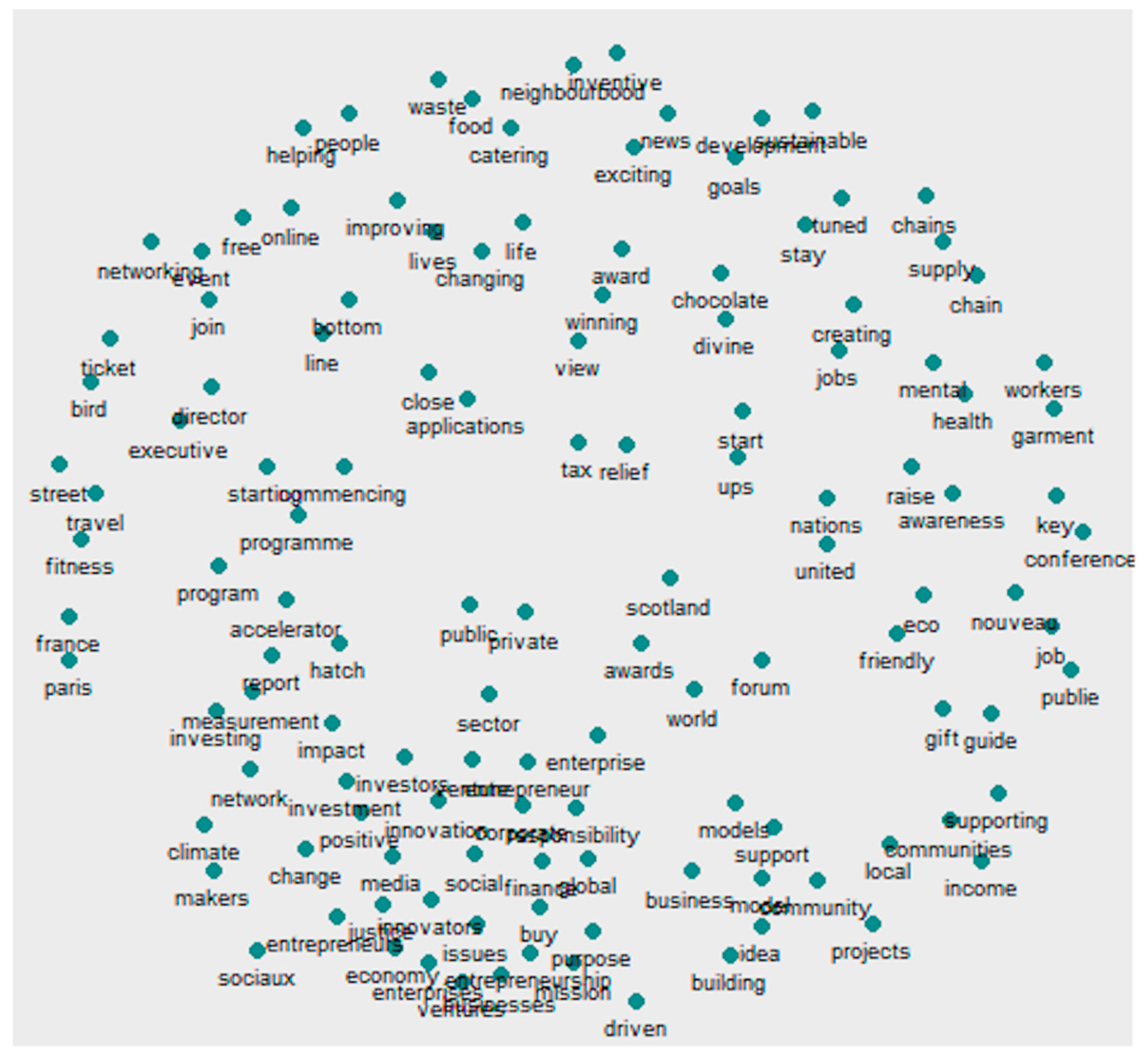
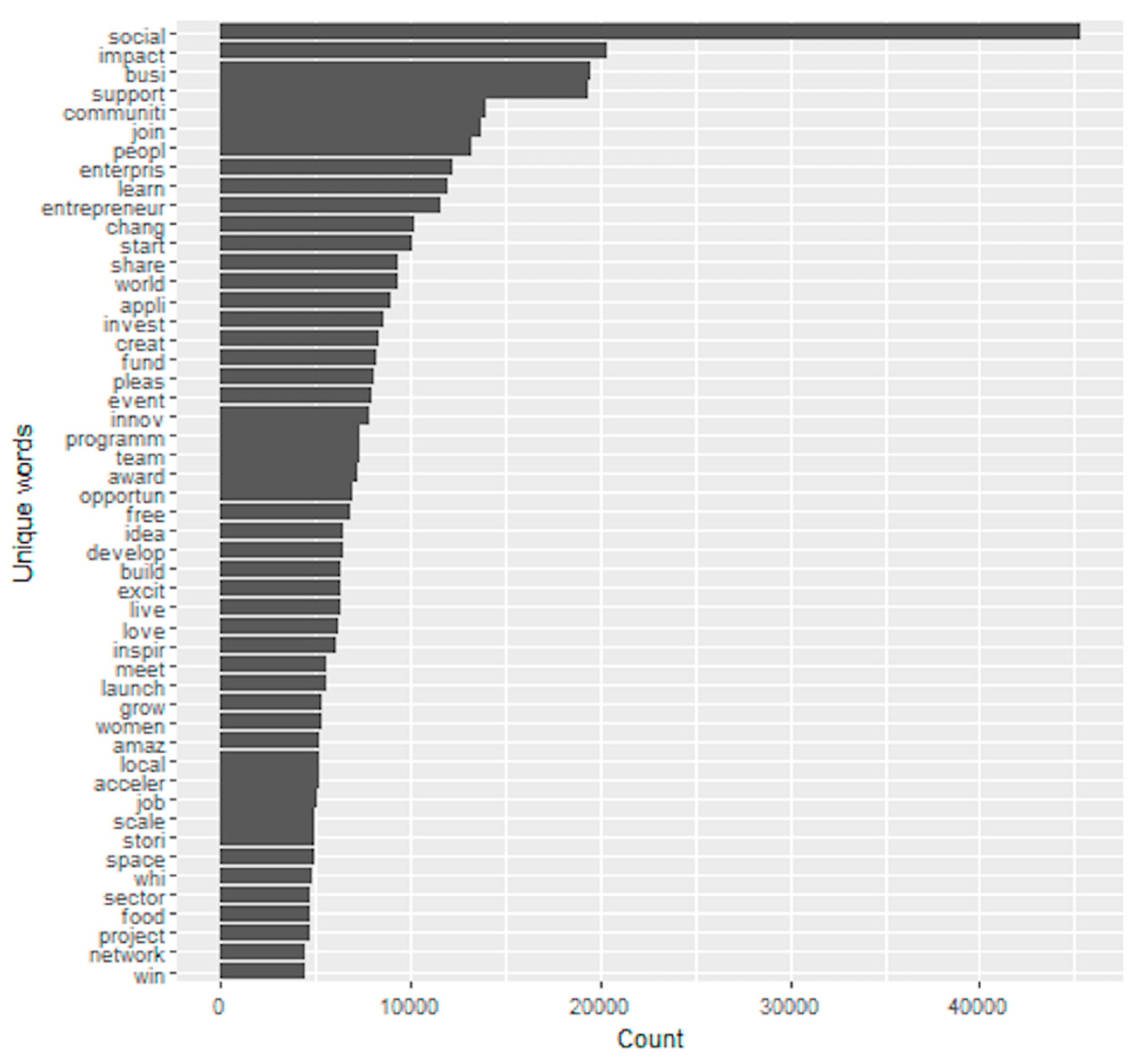
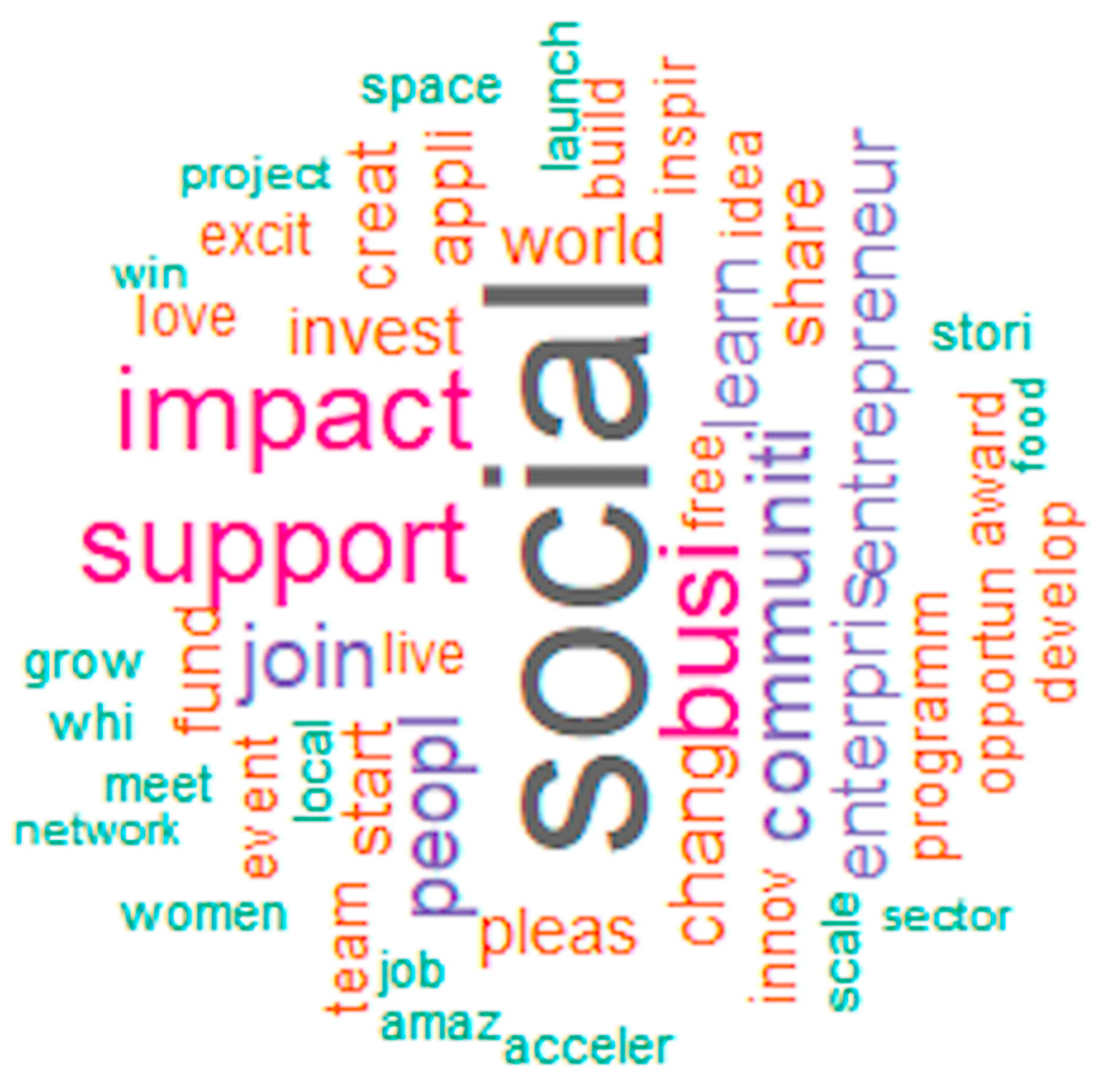
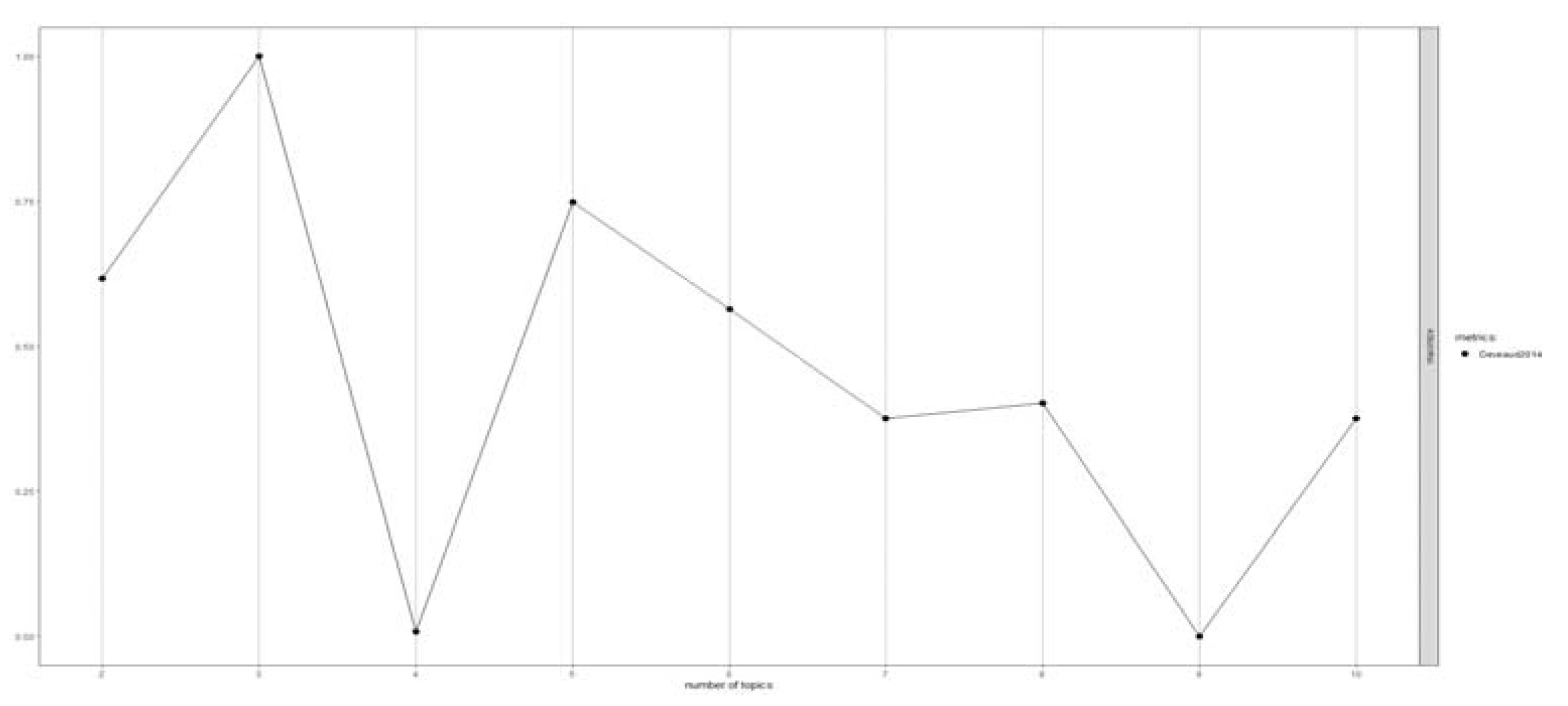
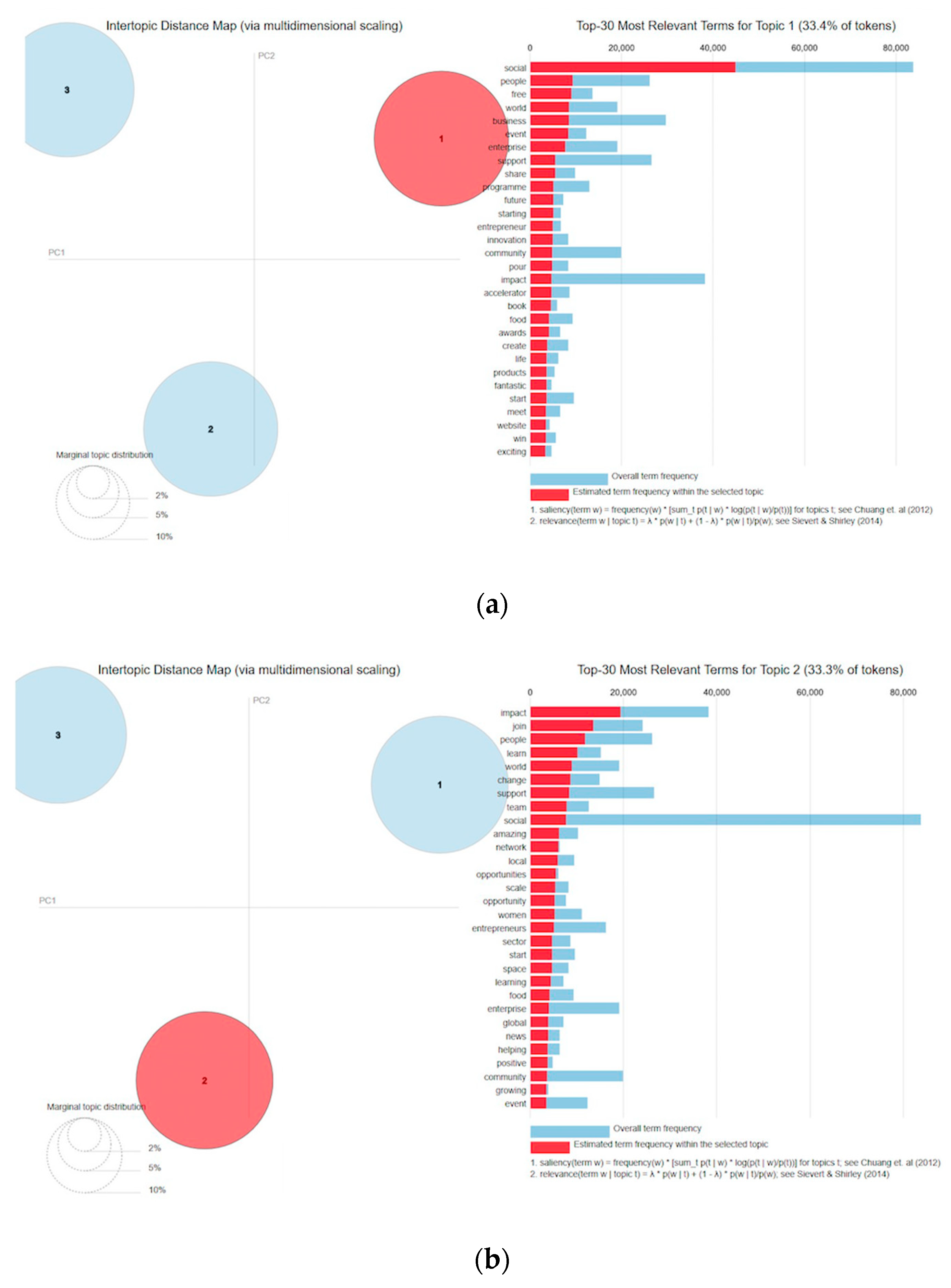
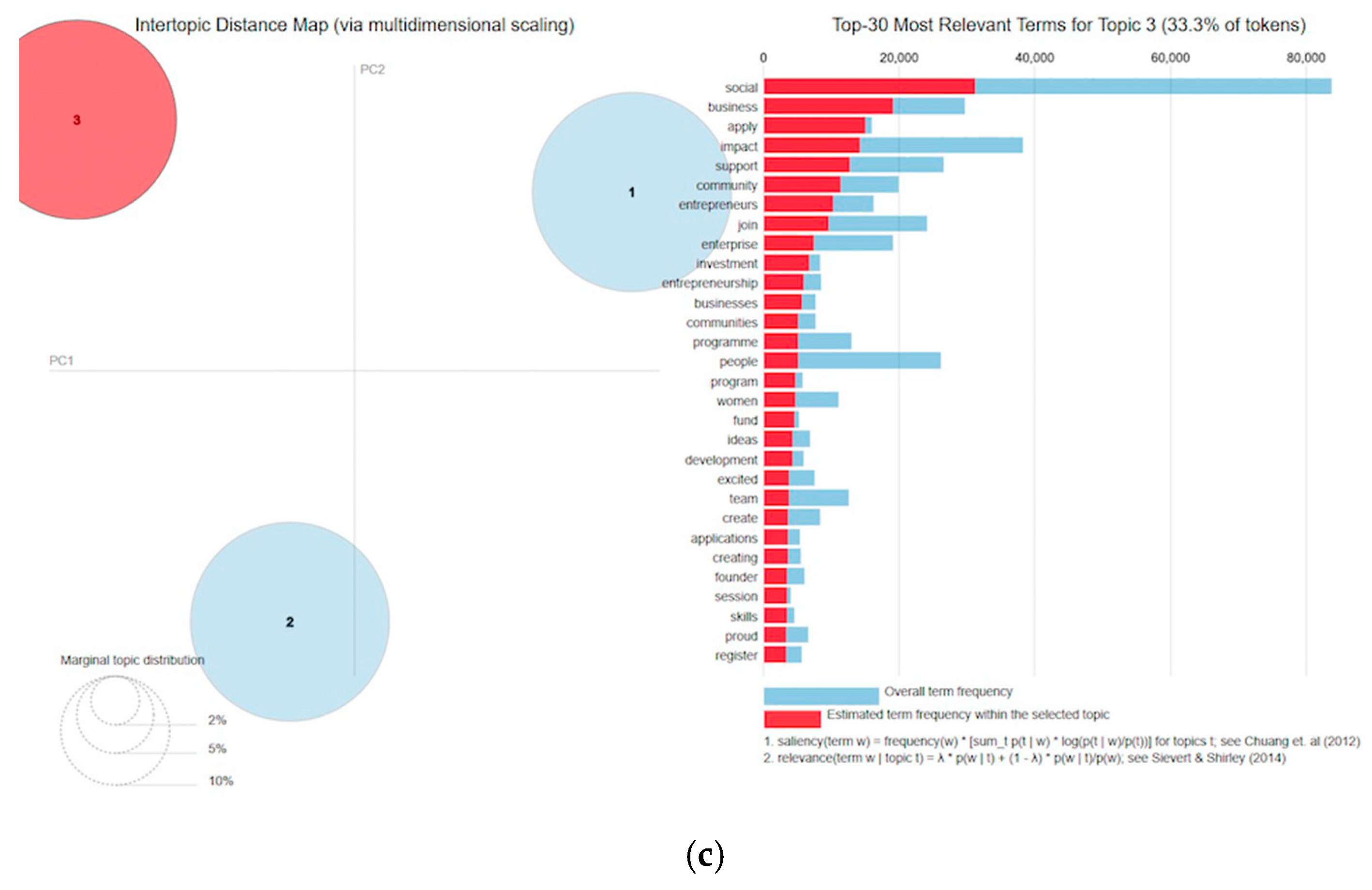
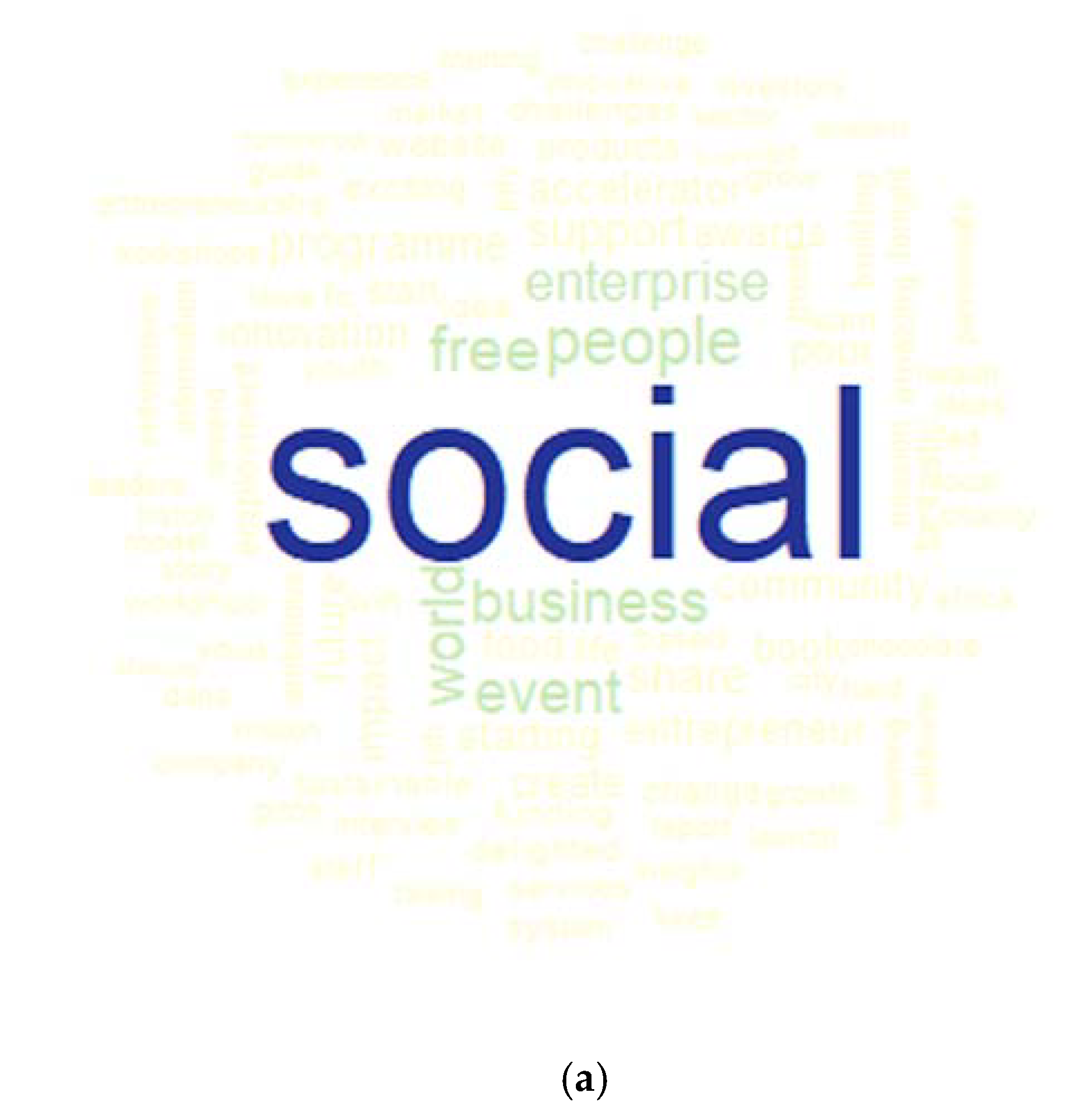
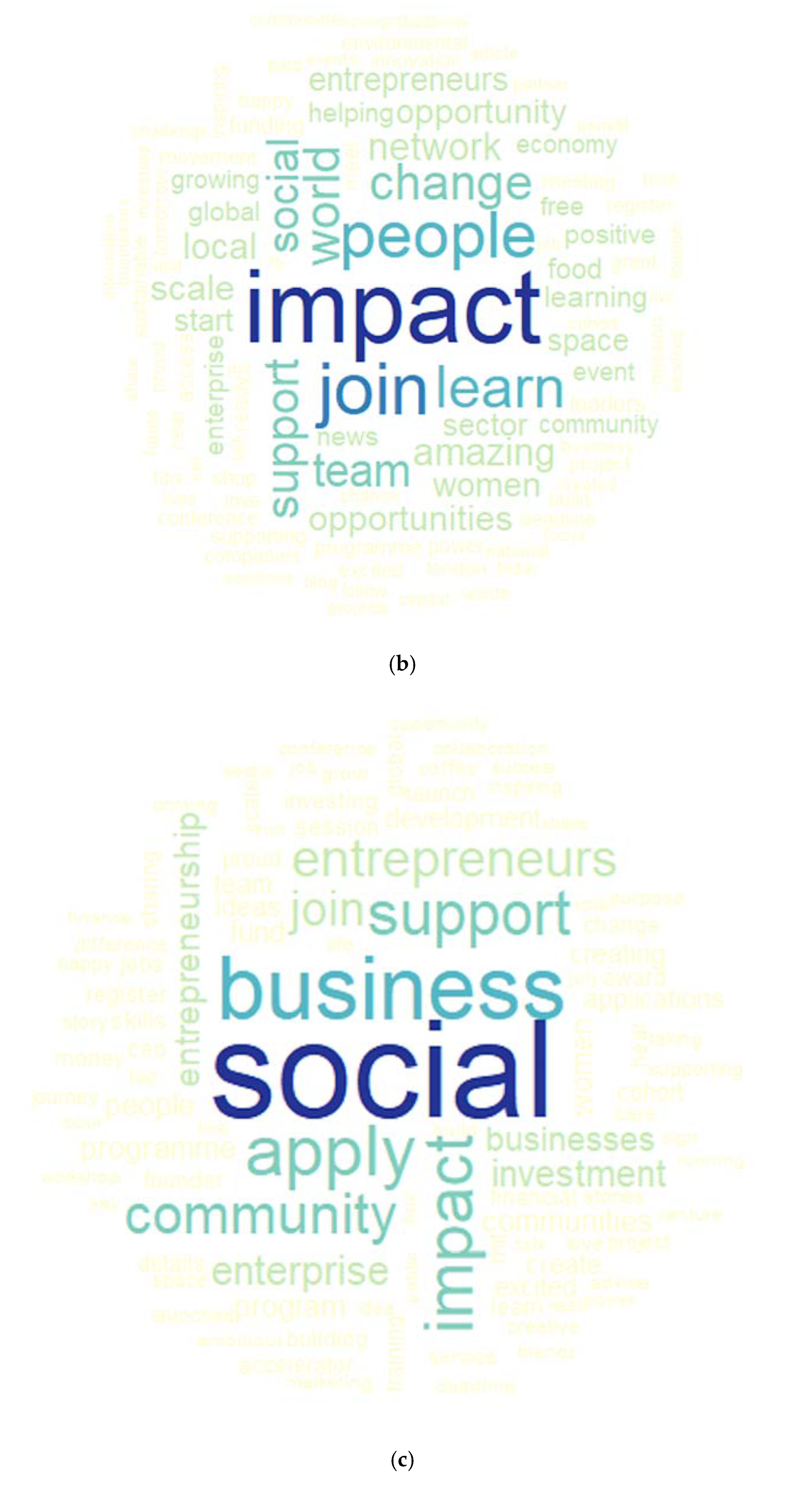
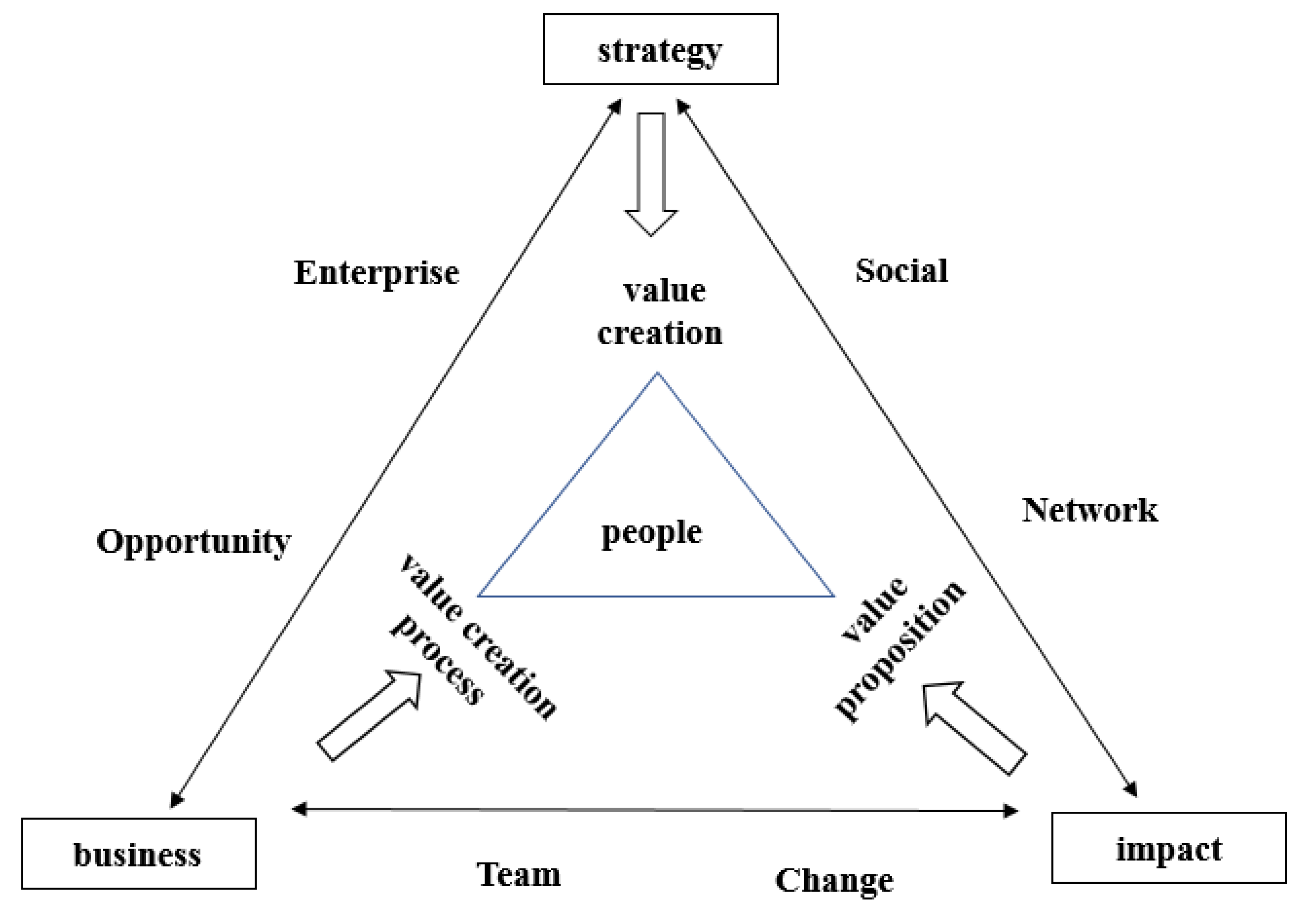
| Topics | Terms |
|---|---|
| Topic 1 | social, people, free, world, business, event, enterprise, support, share, programme, future, starting, entrepreneur, innovation, community, pour, impact, accelerator, book, food, awards, create, life, products, fantastic, start, meet, website, win, exciting, change, employment, amazing, challenges, idea, city, love, award, workshop, funding, youth, sustainable, based, building, grow, delighted, story, ambitious, chocolate |
| Topic 2 | impact, join, people, learn, world, change, support, team, social, amazing, network, local, opportunities, scale, opportunity, women, entrepreneurs, sector, start, space, learning, food, enterprise, global, news, helping, positive, community, growing, event, free, economy, leaders, funding, meet, ready, access, programme, meeting, movement, shop, sustainable, tomorrow, happy, power, supporting, excited, innovation, proud, love |
| Topic 3 | social, business, apply, impact, support, community, entrepreneurs, join, enterprise, investment, entrepreneurship, businesses, communities, programme, people, program, women, fund, ideas, development, excited, team, create, applications, creating, founder, session, skills, proud, register, ceo, cohort, hear, investing, jobs, mit, building, change, launch, training, award, learn, scale, global, sharing, money, financial, details, accelerator, story |
| Topics | Topic Label | Top 10 Words |
|---|---|---|
| Topic 1 | Social strategy | social, people, free, world, business, event, enterprise, support, share, programme |
| Topic 2 | Social impact | impact, join, people, learn, world, change, support, team, social, amazing |
| Topic 3 | Social business | social, business, apply, impact, support, community, entrepreneurs, join, enterprise, investment |
© 2020 by the authors. Licensee MDPI, Basel, Switzerland. This article is an open access article distributed under the terms and conditions of the Creative Commons Attribution (CC BY) license (http://creativecommons.org/licenses/by/4.0/).
Share and Cite
Kao, S.-W.; Luarn, P. Topic Modeling Analysis of Social Enterprises: Twitter Evidence. Sustainability 2020, 12, 3419. https://doi.org/10.3390/su12083419
Kao S-W, Luarn P. Topic Modeling Analysis of Social Enterprises: Twitter Evidence. Sustainability. 2020; 12(8):3419. https://doi.org/10.3390/su12083419
Chicago/Turabian StyleKao, Shr-Wei, and Pin Luarn. 2020. "Topic Modeling Analysis of Social Enterprises: Twitter Evidence" Sustainability 12, no. 8: 3419. https://doi.org/10.3390/su12083419
APA StyleKao, S.-W., & Luarn, P. (2020). Topic Modeling Analysis of Social Enterprises: Twitter Evidence. Sustainability, 12(8), 3419. https://doi.org/10.3390/su12083419





